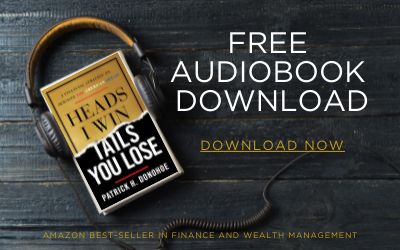Market volatility is an unavoidable reality in investing, yet it often triggers fear-driven decisions that can jeopardize long-term financial success. When markets swing unpredictably—whether due to economic uncertainty, inflation, or global events—many investors react by pulling their money out or scrambling for short-term solutions. However, true financial security comes from a strategy that prioritizes stability, control, and long-term growth—not speculation.
That’s why The Perpetual Wealth Strategy™ offers a smarter way forward. By focusing on financial certainty, liquidity, and protection, this approach allows investors to navigate market fluctuations with confidence, rather than reacting to them in panic. Instead of riding the highs and lows of the stock market, you can build a foundation that ensures lasting financial independence, regardless of economic conditions.
The Reality of Market Volatility
Market volatility is an unavoidable part of investing. Stock prices fluctuate due to economic conditions, investor sentiment, and global events. While market growth can create wealth, sudden downturns often lead to panic-driven decisions that negatively impact financial stability.
To build long-term financial security, investors must understand:
- How market cycles work and why fluctuations are normal
- Why economic downturns are inevitable and how to prepare
- The dangers of reactionary investing and how to avoid costly mistakes
Understanding Market Cycles: Highs, crashes, and corrections
The stock market moves in predictable cycles, though the timing and severity of these shifts can vary. The general pattern includes:
- Bull market (highs): Stock prices rise, investor confidence grows, and people continue buying, expecting further gains
- Market peak: After steady growth, stocks reach a high point, and investors start questioning sustainability
- Market correction: A decline of 10% or more from recent highs; a natural and necessary adjustment to prevent excessive overvaluation
- Bear market (crash): A decline of 20% or more, often driven by panic selling, economic downturns, or major global events
- Recovery & growth: After a downturn, the market eventually rebounds, leading to new opportunities for growth
Why Economic Downturns Are Inevitable
Market downturns happen for several reasons, many of which are beyond individual control:
- Recessions: Economic slowdowns cause businesses to earn less, unemployment to rise, and consumer spending to decline, weakening investor confidence
- Inflation & rising interest rates: When inflation is high, the Federal Reserve may raise interest rates to slow borrowing, making stocks and other investments less attractive
- Global events: Wars, pandemics, trade disruptions, and political instability create uncertainty, leading to stock market declines
- Speculation & asset bubbles: When investors rush to buy overvalued assets, market corrections or crashes often follow once the bubble bursts
Since downturns are inevitable, the key is to have a financial strategy that minimizes risk and maintains stability even in volatile markets.
The Dangers of Reactionary Investing
Market volatility often leads to fear-based financial decisions, which can harm long-term financial growth. Common mistakes include:
- Selling at the wrong time: Investors who sell stocks during a downturn often lock in losses and miss out on recovery
- Chasing quick fixes: Reacting to short-term market changes by constantly shifting investments can lead to missed opportunities and increased risk
- Ignoring long-term strategies: Focusing only on immediate market fluctuations instead of following a stable, proven investment approach can result in inconsistent financial growth
The Psychology of Risk in Investing
Investing comes with uncertainty, and many people are conditioned to believe that market volatility is simply part of the process. Financial advisors, media outlets, and conventional wisdom often push the idea that taking bigger risks leads to bigger rewards—but is that really true?
Understanding the psychology of risk in investing can help you break free from fear-driven decisions, challenge common myths, and take control of your financial future.
Why Investors Are Conditioned to Believe in “High Risk, High Reward”
From an early age, many people are taught that success requires risk. This belief carries over into investing, where traditional advice suggests that the more risk you take, the more money you’ll make.
However, history has proven that high risk does not always lead to high returns. Investors who blindly follow stock market trends without a clear strategy often suffer losses when the market crashes. Market volatility creates uncertainty, and without a solid financial foundation, investors are left exposed to unnecessary risks.
The truth is, smart investing is not about gambling—it’s about strategy. The key to building lasting wealth is control, stability, and liquidity, not reckless speculation.
The Myth of Mutual Funds as a Safe Diversification Tool
Many financial planners promote mutual funds as a safe way to diversify investments. They claim that by investing in a mix of stocks across different sectors, investors can spread their risk and reduce exposure to market downturns.
But here’s the reality:
- Mutual funds are still tied to the stock market when the market crashes, most mutual funds drop in value as well
- Investors have little control over their money, as fund managers make decisions on their behalf
- Fees and taxes eat into potential profits, making it harder to see real growth
Simply put, diversification alone does not eliminate risk. True financial security comes from owning assets that are not subject to market fluctuations, such as high cash value whole life insurance.
How Financial Planners Encourage Risk-Taking Without Real Control
Traditional financial planners are trained to follow Wall Street’s approach to investing. Many encourage clients to keep their money in the stock market, despite knowing that market volatility can erase years of gains in an instant.
Some of the common tactics used to promote high-risk investing include:
- Risk tolerance assessments: Instead of helping clients reduce risk, advisors ask how much they are “willing to lose”
- Long-term market predictions: Investors are told to “ride out the storm,” even when market downturns last for years
- False promises of average returns: Many advisors quote historical average stock market returns, failing to mention that actual returns vary greatly depending on timing
Instead of giving investors real control over their financial future, the traditional system keeps them dependent on market speculation.
The Smart Approach: Risk Mitigation & Asset Allocation
Many investors believe that the key to success is determining how much risk they can handle. Financial advisors often ask, “What is your risk tolerance?” as if losing money is an unavoidable part of wealth-building. But the real question isn’t: “How much risk can I take?”
Instead, investors should be asking:
- “How can I reduce risk while maximizing opportunity?”
- “How do I take back control of my investments?”
The traditional approach to investing—riding market volatility and hoping for long-term gains—puts financial security at risk. A smarter strategy focuses on risk mitigation and asset allocation, ensuring that wealth is built on a strong foundation of control, liquidity, and security.
The Importance of Risk Mitigation in Investing
Risk is often seen as a necessary part of investing, but unnecessary risk leads to financial instability. A market downturn can erase years of gains, leaving investors scrambling to recover.
To protect wealth from market volatility, investors need to:
- Prioritize financial security over speculation
- Avoid being overexposed to high-risk assets like stocks and mutual funds
- Ensure access to liquid assets that provide financial flexibility
The key to long-term success is balancing risk and reward while maintaining financial control.
Asset Allocation: The Key to Long-Term Stability
A strong financial strategy requires diversification across different types of assets. However, not all diversification is equal. Many investors spread their wealth across stocks, bonds, and mutual funds, believing this provides security. The problem? These assets are all still tied to the stock market.
Instead of relying solely on market-based assets, investors should allocate their wealth in a way that ensures stability, liquidity, and growth—regardless of economic conditions.
The Hierarchy of Wealth™: A Smarter Way to Build Wealth
At Paradigm Life, we use The Hierarchy of Wealth™ to evaluate and categorize different asset classes based on risk, liquidity, and control.
This framework helps investors prioritize financial security while maximizing opportunities for growth. The four tiers include:
- Tier 1: Safe, liquid assets
- Examples: High cash value whole life insurance, emergency savings.
- Purpose: Provides financial stability, liquidity, and immediate access to capital.
- Why it matters: Ensures financial security in any market condition.
- Tier 2: Cash-flowing assets with moderate risk
- Examples: Real estate, business investments
- Purpose: Generates income while maintaining some level of control
- Why it matters: Builds long-term wealth without relying on stock market performance
- Tier 3: Growth-focused investments with higher risk
- Examples: Stocks, mutual funds, retirement accounts
- Purpose: Offers long-term potential but with increased exposure to volatility
- Why it matters: Should only be pursued after securing Tiers 1 and 2
- Tier 4: Speculative investments
- Examples: Startups, cryptocurrency, high-risk ventures
- Purpose: Offers the highest potential return but with extreme risk
- Why it matters: Should only be considered once a strong financial foundation is established
Why Wealth-Building Should Start with Control, Liquidity, and Security
Many investors start with high-risk investments, hoping for quick gains. But without a strong financial foundation, they are left exposed when market downturns occur.
A smart approach to asset allocation ensures that:
- You always have liquid assets available in times of need
- Your financial foundation remains secure, even during market downturns
Reducing Market Volatility with Whole Life Insurance
Market volatility can create uncertainty, causing investors to feel anxious about their financial future. When stock prices swing up and down, many people worry about losing their savings, delaying retirement, or missing out on investment growth. The key to financial security is not chasing market gains but building a strong foundation that remains stable no matter what happens in the economy.
One of the most effective ways to protect wealth from market volatility is through high cash value whole life insurance. Unlike stocks, bonds, or mutual funds, this financial tool provides stability, liquidity, and long-term growth without exposure to market risks.
Why Whole Life Insurance Is a Powerful Financial Foundation
Unlike traditional investments that fluctuate with the stock market, high cash value whole life insurance offers guaranteed growth and financial protection. It acts as a secure, tax-advantaged asset that allows investors to:
- Avoid market losses: Whole life insurance cash value does not drop when the stock market crashes
- Grow wealth predictably: Policyholders receive a guaranteed rate of return plus potential dividends
- Access liquidity anytime: Funds can be borrowed against without penalties, restrictions, or market timing concerns
- Protect assets from risk: Policy loans provide cash flow without requiring the sale of investments at a loss
Because of these benefits, whole life insurance serves as a reliable financial foundation that strengthens other investments and creates long-term stability.
Key Benefits of a Wealth Maximization Account™
Building wealth is not just about growing your money—it’s about protecting and controlling it. Market volatility can put traditional investments at risk, leaving many investors worried about stock market crashes, rising taxes, and financial instability.
That’s why The Wealth Maximization Account™ offers a better solution. This properly structured high cash value whole life insurance policy provides certainty, control, and financial flexibility, ensuring that your wealth remains secure no matter what happens in the economy.
Here’s how a Wealth Maximization Account™ can help you protect and grow your wealth with confidence.
Certainty: Guaranteed growth with stable returns
Unlike stocks, mutual funds, or other market-based investments, The Wealth Maximization Account™ offers guaranteed growth. Policyholders benefit from:
- Stable, predictable returns that are not affected by stock market volatility
- Tax-deferred cash value accumulation, allowing your money to grow faster over time
- Potential dividends from mutual insurance companies, further increasing your wealth
This level of certainty ensures that your financial future is not dependent on unpredictable market cycles.
Control: Reduced tax liability and protection from market losses
With traditional investments, you have limited control over your money. You may face:
- Stock market crashes that wipe out years of gains
- Unexpected tax increases on retirement withdrawals
- Restrictions on accessing your own funds
A Wealth Maximization Account™ eliminates these concerns by:
- Providing tax-free policy loans, so you can access money without triggering capital gains taxes
- Keeping your cash value protected from market downturns
- Allowing you to decide how and when to use your money—without penalties
Instead of relying on market performance or government policies, you maintain full control over your financial future.
Liquidity: Access cash value anytime without penalties
A major problem with traditional retirement accounts is lack of liquidity. With a 401(k) or IRA, withdrawing money before retirement age can result in:
- Early withdrawal penalties
- Higher taxes
- Loss of future investment growth
A Wealth Maximization Account™ provides liquidity when you need it. Your cash value is always available, meaning you can:
- Borrow against your policy without restrictions
- Use funds for investments, emergencies, or business opportunities
- Repay policy loans on your own terms
This financial flexibility ensures that you never have to worry about market timing or unexpected expenses.
Protection: A financial safety net against downturns
Market volatility can erase years of investment growth in just weeks. Traditional investment strategies leave investors exposed to stock market fluctuations, causing financial uncertainty.
A Wealth Maximization Account™ serves as a financial safety net, offering:
- Consistent cash value growth, even during recessions
- Protection from stock market losses
- A reliable, tax-free source of income when markets decline
This ensures that your wealth remains intact regardless of economic conditions.
Cash Flow: Retirement income that won’t run out
Many retirees fear outliving their savings due to:
- Stock market downturns reducing portfolio value
- Rising taxes on retirement account withdrawals
- Unpredictable inflation increasing living costs
A Wealth Maximization Account™ provides a steady, tax-advantaged income stream in retirement by:
- Allowing tax-free withdrawals through policy loans
- Ensuring your money continues growing even when borrowed against
- Providing predictable cash flow without market risks
With this strategy, you can enjoy retirement without worrying about running out of money.
Legacy: A wealth-building strategy used by the Rockefellers
Wealthy families, including the Rockefellers, have used high cash value whole life insurance to build and preserve generational wealth. Unlike traditional investments, which can be lost in market downturns, a Wealth Maximization Account™ allows you to pass on financial security to future generations.
Key legacy benefits include:
- A tax-free death benefit, ensuring your heirs receive more of your wealth
- Asset protection from lawsuits, creditors, and excessive taxation
- A private, tax-efficient way to transfer wealth across generations
Money in a Wealth Maximization Account won’t be subject to future market loss. It will accumulate and earn tax-free dividends. If you need liquidity, the money is available to you quickly and easily. Cash value life insurance plays the role of your savings, emergency account, and opportunity fund all in one.
To learn more about how a Wealth Maximization Account can offer you stability and opportunity in times of market volatility, take our free eCourse.
FAQs About Market Volatility
Why is it important to discuss the concept of identifying opportunities in market volatility?
Discussing opportunities in market volatility is essential because it helps individuals understand that market fluctuations are a natural part of investing, and with the right strategies, they can use these fluctuations to their advantage in growing their investments.
What are some key strategies that individuals can employ to navigate market volatility and make informed investment decisions?
Key strategies include maintaining a diversified portfolio, adopting a long-term perspective, staying informed about market trends, and considering dollar-cost averaging to manage risk during market volatility.
How can individuals benefit from recognizing and capitalizing on opportunities in market volatility, and how can they apply these insights to their investment approach?
Recognizing and capitalizing on opportunities in market volatility can empower individuals to make rational investment decisions, seize favorable market conditions, and work towards achieving their financial goals with confidence.
A Smarter Way to Navigate Market Volatility
Market volatility is inevitable, but financial uncertainty doesn’t have to be. Relying solely on traditional investments exposes wealth to market swings, economic downturns, and unpredictable risks. Instead of reacting to market changes, investors need a strategy that provides stability, liquidity, and long-term growth—regardless of economic conditions.
That’s where The Perpetual Wealth Strategy™ comes in. By leveraging The Wealth Maximization Account™, investors can protect their assets, maintain financial flexibility, and create lasting wealth.Ready to take control of your financial future? Schedule a free consultation with a Paradigm Life Wealth Strategist today and learn how to build a secure, market-proof wealth strategy. Plus, get access to our free eCourse on The Wealth Maximization Account™ to start your journey toward financial independence.







